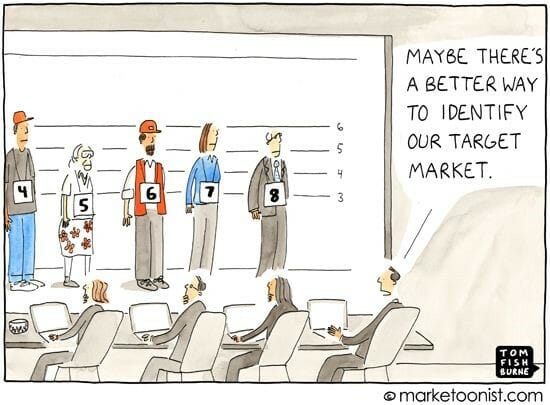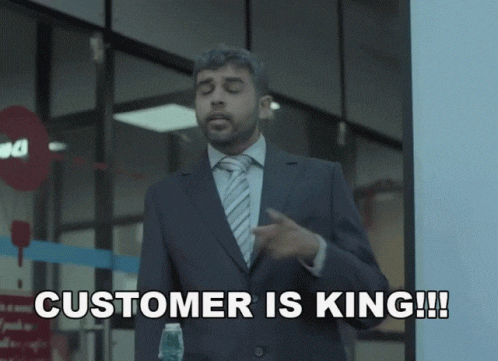Customers play an essential part in any business model. Their needs differ, and so should the approaches to reach them. A marketer’s goal is to win customer satisfaction while generating profits. So, are we saying profiling customer similarities, recognizing differences, and grouping them is the core of B2B Market Segmentation? Absolutely! But how should we go about it? Just walk down the blog.

Source – Marketoonist.
What is customer segmentation?
Heard of divide and rule? Customer segmentation is similar to that – divide and win. It is a process of dividing prospects, customers, and audiences into groups based on their common characteristics. Segmenting your customers allows you to create tailored marketing approaches, making it narrower to target groups instead of a one-size-fits-all approach.
Customer segmentation helps you cater your marketing efforts to your target market. By aligning your revenue and marketing teams on the audiences to target (and those to avoid), you can streamline your internal and external strategies – from content segmentations to marketing analysis and reporting.
Note that creating customer segments will not disturb your content, SEO, or email strategies. Instead, it enhances them. In a world where customers expect customized experiences, marketers must establish realistic goals and build effective data models. However, the hitch is to be wary of applying B2C segmentation approaches to B2B. While there are instances where few marketing methods worked for both, it doesn’t always translate well for the latter.
Why is customer segmentation important in B2B marketing? – The benefits
A runway to customization, market segmentation is proving increasingly valuable to modern consumers. Millennials are among the demographics who value personalization most in B2B transactions. Customized outreach is 1.7 times more likely to gain market share than companies with moderate personalization. Personalization is just the beginning of B2B segmentation’s benefits. What’s more?
- Enhances revenue: A personalized campaign using market segmentation can boost sales by around 10%, according to McKinsey. Conversion rates increase when you reach out to the groups most interested in your products. Thus, you sell more and make more.
- Boost user experience: With customer segments, explore the UX elements that work in favor and those that don’t. For instance, if you segment customers based on the sales cycle, you can see where customers are most likely to churn. The problem is solved once you identify common pain points and fix them.
- Facilitates product development: Market segmentation is a gateway to reaching your core customers. The better you understand, the greater you can serve them. Eventually, it works as a loop, helping you discover customer personas and changing patterns to create niche-specific products.
- Cost-effective marketing: Spending your budget on marketing strategies that don’t work is a waste. You can create more targeted, personalized campaigns with a robust segmentation strategy. McKinsey reports that personalized campaigns are 5x to 8x more effective than traditional campaigns.
- Expand your market horizons: Exploring new B2B markets can be easier when you analyze market segmentation data. So, tap the untapped markets like never before!
But how would you know exactly where to start your B2B market segmentation? Is it applicable across the marketing channels? Or are there specific areas to look for? Read on!
Key areas for B2B customer segmentation – A marketer’s path to faster growth
Customer experience
Every customer interacts with your products differently. It’s important to segment customers to understand their unique journeys. For example, individual contributors and senior managers will have different needs when using a software tool, requiring different journeys with various resources.
Identifying your most valuable customers can also be achieved. By prioritizing and focusing on your most profitable and best customers first, your efforts can be spent on improving their experience rather than trying to optimize for everyone.
Content Marketing
Mercedes-Benz segments its audience to reach people who can afford a high-end car and who know its quality. This strategy applies to businesses across. Brewing relentless content leads to nothing but an exhaustive content repository. You’re serving no one when you market to everyone. So segment who’s interested in your content and sell only to them. One way to get the real readers – get them subscribed!
ABM
When it comes to account-based marketing (ABM), you might target accounts from a few key segments. ABM focuses on time, resources, and budget on a select group of high-value accounts, making it crucial to identify which segments to target. More knowledge about these segments will increase the success of your ABM strategy.
Advertising
Needless to say, it’s a single shot or failure when dealing with high-qualified B2B audiences. Again, there’s a mountain of scope for customer segmentation. Example? A customer looking for WordPress hosting might not need built-in website themes. Know whom you’re selling to and sell only what they need.
Product Marketing
Stage 1 of product marketing begins when a marketer plays the customer’s role. If you think about the product from a customer’s pain points, then you will find the right solution.
How to do customer segmentation in B2B marketing?
As discussed, profiling customers, creating personas, and segmenting them can be done using various parameters. Furthermore, the process is different from B2C customer segmentation. So, here are the top methods for B2B market segmentation.
Demographic
This method divides audiences into groups based on age, occupation, education, income, and nationality. It’s easy to access demographic data and can be combined with other types of customer data to refine your target audience further.
Demographics are limited in B2B marketing. You can use demographic information to determine your target customers, but it won’t tell why they might buy your product. You must also consider customer concerns, needs, and preferences to identify new, undiscovered, and lucrative markets.
Firmographic
Firmographic segmentation identifies audiences by organizational characteristics, such as industry size, number of employees, funding, company size, tech stack, location, and annual revenue. A company’s firmographic data is like an individual’s demographic data.
For lead routing, you can use firmographic information to define ideal customer profiles and sales territories. Additionally, your marketing messages can be tailored and fine-tuned to appeal to organizations that are most likely to be interested in your product. Remember the Mercedes-Benz strategy? A CRM can provide you with firmographic data that can be used to identify potential investors.
Behavioral
This segmentation looks at what customers do with your products/solutions, when, and how often they do it. Prospective customers are segmented by their interaction with your company, products, and marketing channels.
A behavioral segmentation focuses on how people engage with a brand and differs from other segmentation techniques. Behavioral segmentation tops the list as the best way to segment customers by 44% of marketers, according to Marketing Week. Also, data points like website activity, purchase behavior, and benefit-oriented purchasing patterns can tell you a lot about your customers.
Customer Tiering
Customer tiering differs from key account segmentation in that it examines a more comprehensive range of factors than revenue generation potential. It may be helpful to consider how influential a particular client is in generating more clients.
For this, you rank customers according to their value to your business. This value can be determined by their profitability potential, lifetime value, or alignment with your objectives. Modern firms use AI and machine learning to create tiers based on client value. Although customer tiering may help you determine which clients need more attention, not all customers have the exact needs.
Value-based
The idea behind value-based segmentation is to capitalize on the potential value of each prospect. Customers can be segmented according to their revenue potential, for instance. Also, you can segment customers based on their alignment with marketing/sales goals. You need answers to a few questions like – Could this be a lifetime customer? Could they bring in a significant amount of revenue?
Resources can be more efficiently allocated with this segmentation model. Like, knowing your target audience’s annual revenue will help you align your pricing strategy with their budgets to avoid overcharging scenarios.
Needs-based
Before segmenting your customers, it is essential to identify their potential needs. How can you encourage them to buy from you besides the quality of your product? In addition to what your competition offers, what else do they need? Perhaps you can differentiate yourself by providing high-quality customer service, a user-friendly interface, ease of onboarding, or something else. Here, surveys can help.
Gain insight into the factors that influence buyers’ decisions. This segmentation allows you to tailor messaging and conversations to address their needs. It’s a perfect go-to B2B market segmentation as it aligns marketing and sales efforts around specific customer pain points.
Make the most out of B2B customer segmentation – Top tips!
- Choose the variables and goals that will help you segment your customers.
- Develop a customer-centric segmentation project that breaks your goals down into practical steps.
- Establish a customer segmentation plan for each project and prioritize them accordingly.
- Data collection and organization are critical to a successful customer segment.
- Create groups of customers based on your preferences.
- Identify and market to your target clients and users.
- Perform customer and market segmentation analysis regularly.
- Evaluate, find voids, and work around.
B2B segmentation helps you build the foundation for a long-lasting customer relationship. By analyzing segmentation data, you learn more about your core customers. Personalizing your marketing messages will enable you to connect with them even better. Boosting conversions, effective cross-team communications, and meeting specific customer needs are a few benefits to start with.
Have you started working on your customer segmentation strategy yet? If it looks overwhelming to put these insights to work, worry not. To stay ahead of the curve, businesses need a digital marketing suite that solves the bottlenecks of marketing. It’s easy to exceed customer expectations when Wild Creek is on your side. Contact us today!

